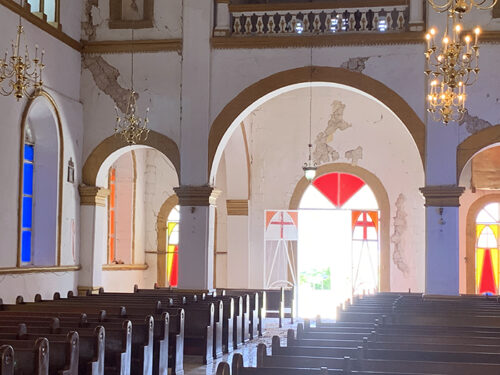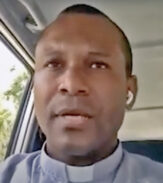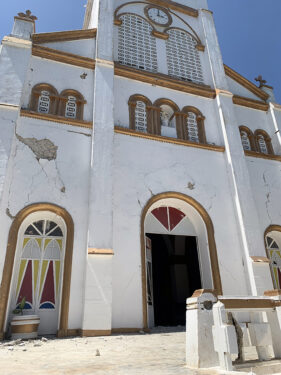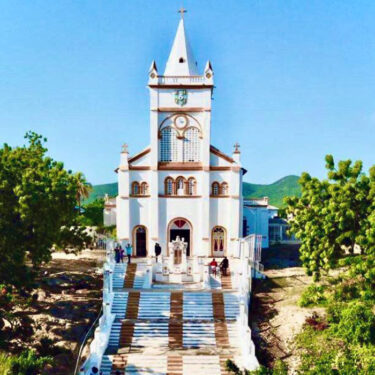
WINDSOR TERRACE — In the deadly earthquake that ravaged Haiti on Aug. 14, St. Anne Cathedral in Anse-à-Veau, which has a special connection to the Diocese of Brooklyn, sustained heavy damage and may need to be destroyed, its pastor sadly reported.
“We are waiting for the engineers to come and evaluate it for us,” Father Louis Merosne explained on Aug. 23. “But to the naked eye, it looks like the whole front definitely will have to come down. It’s way too dangerous for people to walk under.
“And on the western side, all the posts are fractured,” Father Merosne added. “There are lines that go through all the posts. So we have to see if they’re superficial lines or if they go deep into the posts. And if they’re broken, then the west side would have to come down as well.
“The whole thing might have to come down,” he said.
But in the midst of that distressing prediction, Father Merosne delivered some good news: somehow, the heavy oak pews and a church bell donated to St. Anne Cathedral by the Diocese of Brooklyn last winter were unscathed in the 7.2-magnitude quake.
Earlier this year, Father Merosne, said his parish set out to raise $700,000 for renovations to the cathedral as part of the parish’s 300th anniversary, held concurrently with the tricentennial of Anse-à-Veau, a tiny community located just a few miles east of the earthquake’s epicenter at Petit-Trou-de-Nippes.
Kicking off the remodeling of the 200-year-old building was the installation of the pews donated by the Diocese’s Office of Patrimony. In its 12th year, the office’s mission is to store and care for items from shut-down churches, schools, and other buildings across the diocese.


St. Anne’s to-do list included a new baptismal, windows, doors, scraping and repainting interior walls, and a touch-up for the ceiling, Father Merosne said.
“So, these projects weren’t done,” he noted. “And it’s probably good that they weren’t because they would have gone to waste with this earthquake.”
Meanwhile, the pastor added, the pews “look beautiful.”
“The bell is beautiful,” he added. “It was going to be raised by the same firm that was going to do the renovations. So, since it hadn’t been raised, it was on the ground. Thank God it was kept safe.”
Now, the cathedral is closed to the public. Whether it is repaired — or demolished and replaced — the donated pews and bell will “absolutely” be future fixtures in the cathedral, Father Merosne said.
The Haitian government’s Civilian Protection Agency reported on Aug. 22 that more than 2,200 people died in the earthquake, and 350 remain missing. Also, 12,250 people have been reported injured, and 53,000 homes were destroyed.
Still, Father Merosne said, the Catholic faith burns brightly in the hearts of Haitians, who are eager to worship and receive sacraments. On Sunday, August 22, he kept a full schedule of celebrating Masses, including a first holy Communion.
He said the Masses normally held at the cathedral are celebrated beneath a tin roof supported by large metal pipes. This multipurpose structure is also where the parish continues feeding hot meals each day to local children.
Even just a few hours after the August 14 earthquake, a funeral scheduled in the cathedral was conducted instead in a public square in front of the rectory.
“I think first of all it is having the will to do it,” Father Merosne said of keeping sacraments available. “Our faith teaches us that we need those things.
“And, therefore, you look for creative ways because we feel the necessity. Necessity is the mother of all invention, and necessity opens your eyes to creativity.”
Going forward, Father Merosne urged people in the U.S. to keep praying for the Church in Haiti and to let Catholics in the beleaguered nation know that they are praying.
He also suggested that U.S. dioceses or parishes enter into “twinning relationships” with counterparts in Haiti to establish long-term recovery efforts. For example, such partnerships could help rebuild quake-ravaged homes or sponsor a Haitian student to come to the U.S. for training in engineering or construction.
“We walk together in faith, accompanying both peoples,” Father Merosne said. “The faithful parishioners in Brooklyn would benefit from the faithful in Haiti who, being so poor yet so grateful to the Lord, are not broken by disasters. That says something — that the Catholicity of the faith will be lived out even more.

